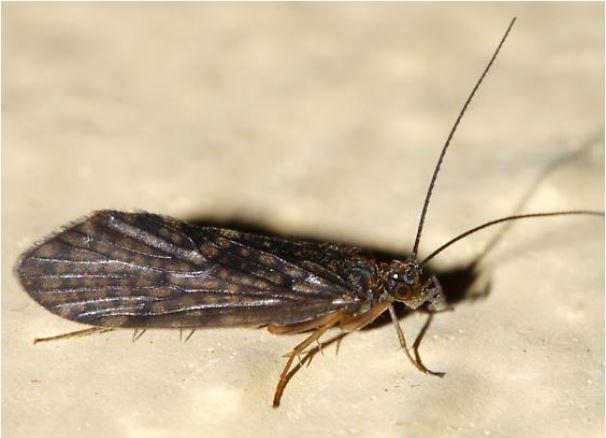Moderate
The population size and trend of yellowstar northern caddisfly is unknown in Washington.
Caddisflies are aquatic insects. They are very sensitive to water quality and changes in water flow. Caddisflies in general are often considered an indicator of high-quality streams, suggesting that they are particularly vulnerable to changes in their habitat.
Description and Range
Physical description
Caddisflies are closely related to the Lepidoptera (moths and butterflies). The adult’s body and wings are covered with long silky hairs (setae) – a distinctive characteristic of the order. Caddisflies are aquatic in the immature stages.
Ecology and life history
This species has a broad altitudinal range from low altitude valley ponds to high mountain ponds and lakes and is tolerant of large temperature variations. It is most abundant in waters without salmonids.
During the day, adults hide in cool, moist environments such as the vegetation along riverbanks. Few caddisfly adults have actually been observed feeding; they imbibe nectar.
Adults live several weeks and usually mate on vegetation or rocks surrounding water. Eggs, in masses numbering up to 800, are laid within a jelly that swells on contact with water. A female may wash off a partially extruded egg mass by dipping her abdomen into water during flight, or she may place the mass on stones in the water or on aquatic plants just above the water. Young larvae hatch within a few days and progress through multiple instars before emerging as a winged adult.
Although most larvae feed on aquatic plants, algae, diatoms, or plant debris, a few are predatory on other aquatic insects, crustaceans, and mollusks, and a few are omnivorous. Limnephilus flavastellus larvae are able to consume the toxic eggs of the rough-skinned newt (Taricha granulosa). The larvae play an important role in the aquatic community, reducing plant growth and disposing of animal and plant debris.
Caddisfly adults sometimes emerge in large numbers, often forming swarms. Adults tend to remain somewhat near the emergence site where oviposition occurs. They tend to disperse shorter distances in dense forest compared with more open vegetation. Although dispersal flights are common, such flights are relatively short and only occur immediately following emergence.
Geographic range
This species has been recorded in Mason County, and was recently reported from Mt. Rainier National Park, Pierce County, Washington. It is also found in British Columbia, Oregon (Douglas, Klamath, Yamhill Counties). The larvae are undescribed/unknown.
For a map of worldwide distribution and conservation status of this species, check out NatureServe Explorer.
Climate vulnerability
Sensitivity to climate change
Moderate
Little information is available on the caddisfly species Limnephilus flavastellus, which can be found in mountainous areas of Washington, Oregon, and British Columbia. Their habitat can include coldwater ponds in forested areas, where they live in the water throughout their larval and pupae stages. This species is likely less sensitive than caddisflies that are restricted only to coldwater streams, as they can tolerate a wider range of conditions found in ponds. Sensitivity for this species reflects their specialized habitat, which is vulnerable to warming air and water temperatures, drought and changing precipitation patterns, sedimentation from upstream erosion, and habitat fragmentation from nearby human activity (i.e. forestry practices and road construction). Caddisflies in general are often considered an indicator of high-quality streams, suggesting that they are may be vulnerable to changes in their habitat.
Exposure to climate change
Moderate
Conservation
Conservation Threats and Actions Needed
- Resource information collection needs
- Threat: Lack of data on current status and distribution
- Action Needed: Determine distribution and population status
- Fish and wildlife habitat loss or degradation
- Threat: Water quality is of extreme importance to aquatic insects
- Action Needed: Protect riparian habitats
- Climate and severe weather
- Threat: Drying of streams
- Action Needed: Determine distribution and population status
See the Climate vulnerability section for more information about the threats posed by climate change to this species.
Resources
References
Anderson, N. H. 1976. The distribution and biology of the Oregon Trichoptera. Oregon Agricultural Experiment Station Technical Bulletin, 134:1-152.
Cannings, R., 2007. Checklist List of the Trichoptera (Caddisflies) of British Columbia. Royal. BC Museum.
Clemson University Department of Entomology (J.C. Morse, ed.). 2002. Last Updated 5 September 2006. Trichoptera World Checklist. Online. Available: http://entweb.clemson.edu/database/trichopt/index.htm.
Gall, B.G., E.D. Brodie III, and E.D. Brodie, Jr. 2011. Survival and growth of the caddisfly Limnephilus flavastellus after predation on toxic eggs of the Rough-skinned Newt (Taricha granulosa). Canadian Journal of Zoology 89:483-489.
NatureServe. 2014. NatureServe Explorer: An online encyclopedia of life [web application]. Version 7.1. NatureServe, Arlington, Virginia. Available http://explorer.natureserve.org.
Nimmo, A.P. and G.G.E. Scudder. 1983. Supplement to an annotated checklist of Trichoptera (Insecta) of British Columbia. Syesis 16: 71-83.
Ruiter, D. E., B. C. Kondratieff, R. A. Lechleitner, and R. E. Zuellig. 2005. An annotated list of the caddisflies (Trichoptera) of Mt. Rainier National Park, Washington, USA. Transactions of the American Entomological Society 131(1/2): 159-187.
Ruiter, D. E. 1995. The genus Limnephilus Leach (Trichoptera: Limnephilidae) of the New World. Ohio Biological Survey Bulletin, new series, 11: 1-200.
D. Ruiter, pers.comm.
